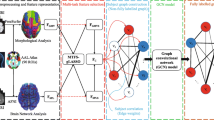Abstract
Though reversing the pathology of Alzheimer’s disease (AD) has so far not been possible, a more tractable goal may be the prevention or slowing of the disease when diagnosed in its earliest stage, such as mild cognitive impairment (MCI). Recent advances in deep modeling approaches trigger a new era for AD/MCI classification. However, it is still difficult to integrate multi-modal imaging data into a single deep model, to gain benefit from complementary datasets as much as possible. To address this challenge, we propose a cascaded deep model to capture both brain structural and functional characteristic for MCI classification. With diffusion tensor imaging (DTI) and functional magnetic resonance imaging (fMRI) data, a graph convolution network (GCN) is constructed based on brain structural connectome and it works with a one-layer recurrent neural network (RNN) which is responsible for inferring the temporal features from brain functional activities. We named this cascaded deep model as Graph Convolutional Recurrent Neural Network (GCRNN). Using Alzheimer’s Disease Neuroimaging Initiative (ADNI-3) dataset as a test-bed, our method can achieve 97.3% accuracy between normal controls (NC) and MCI patients.
Access this chapter
Tax calculation will be finalised at checkout
Purchases are for personal use only
Similar content being viewed by others
References
Alzheimer’s Association: 2019 Alzheimer’s Disease Facts and Figures Report. https://www.alz.org/alzheimers-dementia/facts-figures
Rowe, C.C., et al.: Amyloid imaging results from the Australian Imaging, Biomarkers and Lifestyle (AIBL) study of aging. Neurobiol. Aging 31, 1275–1283 (2010)
Jagust, W.J., et al.: The Alzheimer’s Disease Neuroimaging Initiative positron emission tomography core. Alzheimers Dement. 6, 221–229 (2010)
Ashburner, J., Friston, K.J.: Voxel-based morphometry—the methods. Neuroimage 11, 805–821 (2000)
Thompson, P.M., Apostolova, L.G.: Computational anatomical methods as applied to ageing and dementia. Br. J. Radiol. 80, S78–S91 (2007)
Vemuri, P., et al.: Accelerated vs. unaccelerated serial MRI based TBM-SyN measurements for clinical trials in Alzheimer’s disease. Neuroimage 113, 61–69 (2015)
Smith, S.M., et al.: Tract-based spatial statistics: voxelwise analysis of multi-subject diffusion data. Neuroimage 31, 1487–1505 (2006)
Jiang, X., et al.: Intrinsic functional component analysis via sparse representation on Alzheimer’s disease neuroimaging initiative database. Brain Connect. 4, 575–586 (2014)
Tong, T., et al.: Multi-modal classification of Alzheimer’s disease using nonlinear graph fusion. Pattern Recogn. 63, 171–181 (2017)
Jack Jr., C.R., et al.: The Alzheimer’s disease neuroimaging initiative (ADNI): MRI methods. J. Magn. Reson. Imaging: Off. J. Int. Soc. Magn. Reson. Med. 27(4), 685–691 (2008)
Liu, M., Zhang, J., Adeli, E., Shen, D.: Deep multi-task multi-channel learning for joint classification and regression of brain status. In: Descoteaux, M., Maier-Hein, L., Franz, A., Jannin, P., Collins, D.L., Duchesne, S. (eds.) MICCAI 2017. LNCS, vol. 10435, pp. 3–11. Springer, Cham (2017). https://doi.org/10.1007/978-3-319-66179-7_1
Parisot, S., et al.: Spectral graph convolutions for population-based disease prediction. In: Descoteaux, M., Maier-Hein, L., Franz, A., Jannin, P., Collins, D.L., Duchesne, S. (eds.) MICCAI 2017. LNCS, vol. 10435, pp. 177–185. Springer, Cham (2017). https://doi.org/10.1007/978-3-319-66179-7_21
ADNI: Alzheimer’s disease neuroimaging initiative. http://adni.loni.usc.edu/
Destrieux, C., et al.: Automatic parcellation of human cortical gyri and sulci using standard anatomical nomenclature. Nuroimage 53(1), 1–15 (2010)
Zhang, X., et al.: Characterization of task-free and task-performance brain states via functional connectome patterns. Med. Image Anal. 17(8), 1106–1122 (2013)
Acknowledgements
The authors thank Dong Wang for the helpful discussions.
Author information
Authors and Affiliations
Corresponding author
Editor information
Editors and Affiliations
Rights and permissions
Copyright information
© 2019 Springer Nature Switzerland AG
About this paper
Cite this paper
Zhang, L., Zaman, A., Wang, L., Yan, J., Zhu, D. (2019). A Cascaded Multi-modality Analysis in Mild Cognitive Impairment. In: Suk, HI., Liu, M., Yan, P., Lian, C. (eds) Machine Learning in Medical Imaging. MLMI 2019. Lecture Notes in Computer Science(), vol 11861. Springer, Cham. https://doi.org/10.1007/978-3-030-32692-0_64
Download citation
DOI: https://doi.org/10.1007/978-3-030-32692-0_64
Published:
Publisher Name: Springer, Cham
Print ISBN: 978-3-030-32691-3
Online ISBN: 978-3-030-32692-0
eBook Packages: Computer ScienceComputer Science (R0)





